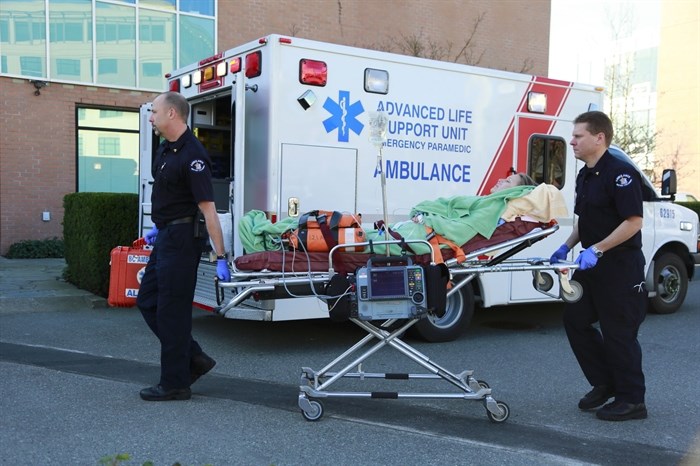
Paramedics are getting to patients quicker in the Interior and that's likely saving lives.
Image Credit: SUBMITTED/B.C. Emergency Health Services
December 19, 2018 - 5:30 PM
KELOWNA - When seconds can make the difference between life and death, getting an ambulance on the scene faster saves lives.
And that’s just what’s happening with a new Clinical Response Model that’s now up and running in B.C.
Rather than send both fire trucks and ambulances to most calls for service, the new system focusses on getting to the most serious cases the fastest. It was launched by B.C. Emergency Health Services on May 30.
“In the Kelowna area, since the introduction of the Clinical Response Model, just for those highest acuity patients - the ones in cardiac arrest or respiratory arrest - we’ve responded to those patients at 42 seconds quicker than we were previously,” Neil Lilley, the agency’s Director of Patient Care, Communications and Planning told iNFOnews.ca.
That means paramedics in ambulances usually reach the most serious cases in 6.5 minutes, Lilley said.
There will also be another 34 paramedics on the job in Kamloops and Kelowna early in the New Year.
The changes were about a year in the making, following a major increase in government funding and include a “treat and release” program to be launched in 2019. That will allow paramedics to treat less serious cases in the home rather than taking patients to hospital.
“Previously, when anyone called 911, it was a very simple system in British Columbia where a call taker would take your call and run through a set of triage questions to identify the severity,” Lilley explained. “We would send an ambulance either on lights and sirens or at normal road speed, and every ambulance would take every patient to the emergency department. As we know, and from doing research around the world, that’s not necessarily the best practice.”
Now the paramedics have the option of taking patients to alternate facilities, such as urgent care centres or “sobering sites,” Lilley said.
Paramedics are getting additional training prior to the “treat and release” program being implemented.
Of the 34 new full-time paramedics, 16 will be in Kelowna and 18 in Kamloops. Both cities have 70 full-time and on-call staff now. In addition, both cities are getting two more ambulances (although one in Kelowna is being moved from Lake Country).
The changes also mean there’s less need for fire trucks to respond in tandem with ambulances.
The old system had both fire trucks and ambulances sent to most calls.
In many cases, fire trucks could respond faster because they were closer than ambulances. Where that’s still the case, fire trucks will respond first so they can provide basic first aid, CPR and defibrillation before paramedics arrive. Now fire trucks won't be responding to less serious cases.
That means the call volume for the Kelowna Fire Department has dropped 30 per cent from about 800 calls a month to 500 in the six months since the new system was implemented.
“The good news is, we’re no longer racing out to non-emergent calls, which is good for everybody,” Kelowna Fire Chief Travis Whiting said. “It allows us to focus on other types of work, without risk to the public.”
The change is not expected to have any detrimental effect on those with less serious injuries or illness.
“The Critical Response Model is about better utilizing our resources so we’re not overcommitting to lower acuity calls but freeing up those resources to be better able to respond to time-critical calls when they’re needed,” Lilley said. “That’s why British Columbia has currently got the best out-of-hospital cardiac survival rate in the whole of Canada.”
The other important resource, that’s been around for a number of years but many people don’t think to access, is the 8-1-1 phone system, Lilley noted. That puts people in contact with nurses who can provide medical advice and, if necessary, still call an ambulance.
One thing that may not change, is the cost to patients who call an ambulance and don’t have medical insurance to cover transport to the hospital, which currently runs at about $400.
While details aren’t final, when the “treat and release” program is implemented next year, it may still charge as much to have a paramedic leave someone at home as to take them to hospital, Lilley said.
WHO IS CALLING FOR AMBULANCES IN THE THOMPSON-OKANAGAN’S FIVE LARGEST CITIES
Calls for ambulances in 2017 (from B.C. Emergency Health Services)
Kelowna: 19,847
Kamloops: 12,243
Vernon: 7,237
Penticton: 6,111
West Kelowna: 4,550
— This story was corrected on Dec. 20, 2018 at 9:12 a.m. to change two references to Whiting to Lilley.
To contact a reporter for this story, email Rob Munro or call 250-808-0143 or email the editor. You can also submit photos, videos or news tips to the newsroom and be entered to win a monthly prize draw.
We welcome your comments and opinions on our stories but play nice. We won't censor or delete comments unless they contain off-topic statements or links, unnecessary vulgarity, false facts, spam or obviously fake profiles. If you have any concerns about what you see in comments, email the editor in the link above.
News from © iNFOnews, 2018